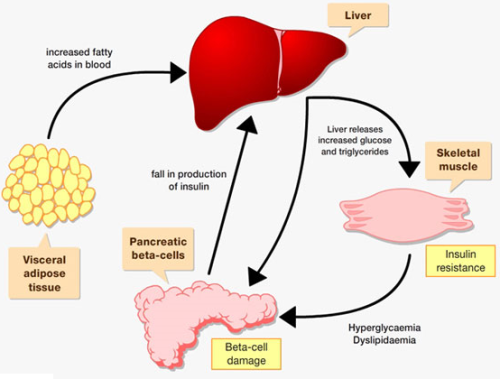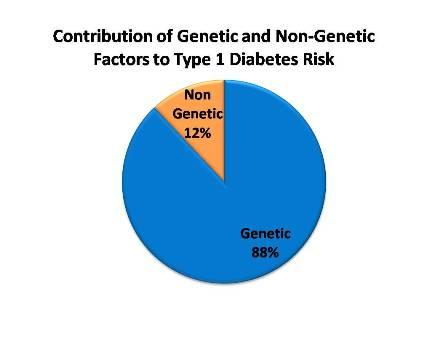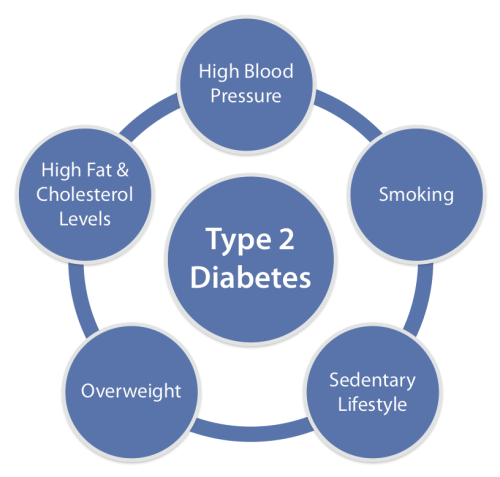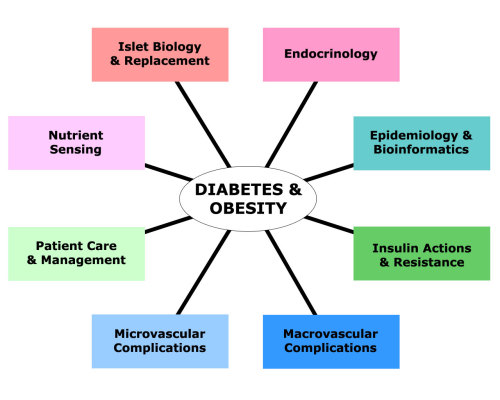Diabetes is a metabolic disorder that can occur in any age. It is characterized by an increase in the blood glucose levels which may be either due to insufficient production of insulin, the inability of body cells to use insulin properly or due to production of defective insulin depending upon the type of diabetes.
While the exact causes of diabetes are still not known, the conditions that characterize diabetes are pretty well agreed upon and symptoms are largely the same. While researches still debate on the exact causes of the disorder, many argue that genetic factors, including the presence of some form of the disease in the history of the family, combined with some special triggers such as some specific environmental factors can lead to individuals developing the condition.

The Role of Glucose
Glucose is the primary fuel of the body. It is the substance which is carried to all parts of the body via the blood and is absorbed by the cells of the body. Glucose is obtained by the body through the process of digestion and is carried out by the liver. When the food is being digested, excess amounts of glucose are also stored by the liver in the form of glycogen. When the body requires more glucose, the liver breaks up the glycogen into glucose and then releases it into the blood stream.
Any physical activity requires more energy and the body cells actively take up more sugar from the blood stream. As the level of glucose in the blood stream decreases, the regulation of the hormone insulin helps to keep the levels in check in order to provide the necessary energy to different parts of the body.
The Effect of Insulin

In order to try and understand the causes of diabetes, first the action of insulin on the body must be understood. Insulin is a hormone that is secreted by the beta cells present in the pancreas. Insulin is responsible for regulating the way in which the cells of the body absorb glucose from the blood stream. In cases of diabetes, the sensitivity of the body to insulin is greatly hindered and the cells of the body are unable to effectively absorb sugar from the blood stream. This is turn, results in a buildup of the concentration of glucose in the blood. When the glucose levels are abnormally high, it leads to the diagnosis of some type of diabetes or prediabetes.
Causes of Type I Diabetes
Type I Diabetes is caused due to insulin deficiency which occurs due to destruction of insulin producing beta cells in the pancreas. It is an autoimmune disease caused due to self-destruction of beta cells by the body’s own defense cells. Latent auto-immune diabetes (LADA) is also found in adults and is often mistaken as Type II diabetes.
Genetic susceptibility and heredity are also causes of Type I Diabetes and some individuals are more prone to developing the condition than others [5]. These genes, which are passed down in a family through generations can determine whether a member will develop the condition in the future. Type I Diabetes occurs more commonly in children and young adults. Heredity gas a major role to play in Type 1 diabetes as it is passed on from one generation to other through genes. HLA or Human Leukocyte Antigens also play an important role in determining the chances of occurrence of diabetes in an individual since these cells help in recognizing the body’s own cells as foreign cells leading to their auto-destruction.

People who are genetically susceptible to developing Type I Diabetes may become diabetic when triggered by environmental factors like diet, viruses, and toxins. However, the exact mechanism or the nature by which this process is triggered is still not known. While some theories suggest that these factors aid in the destruction of the beta cells, some other theories seem to suggest that these factors play a longer and ongoing role in the condition.
While a virus or an infection cannot trigger Type I Diabetes on their own, there has often been a link which suggests that certain factors can trigger the condition in individuals who are already at the risk of developing the disease [4]. Some of the commonly associated pathogens include:
- Cytomegalovirus
- Rubella
- Adenovirus
- Coxsackievirus
- Mumps
There is active research being carried out in order to develop a vaccine which can help individuals fight these pathogens.
Infants, who face improper feeding practices, such as the early or late introduction of cereal to the diet, or an early exposure to cow’s milk rather than mother’s milk are at a higher risk of developing Type I Diabetes.
Type I Diabetes mellitus can also be controlled or corrected by intake of insulin as a curative measure.
Causes of Type 2 Diabetes
Type II Diabetes is caused due to a number of factors like insulin resistance, where the body’s muscle, fat, and liver cells become ineffective to use up all the insulin. Type II Diabetes occurs when the body is no longer able to produce enough insulin as a compensatory mechanism.
Type II Diabetes is more prevalent than Type I Diabetes as it is found in almost 90% of the total diabetic cases whereas less than 10% of diabetics suffer from Type I Diabetes. Type II Diabetes develops commonly in middle-aged and old people and more often in overweight or obese individuals. Triggers of Type II Diabetes include genetic susceptibility, lifestyle or dietary factors. Various studies have been done all over the world to prove that Type II Diabetes is caused due to obesity and physical inactivity in the youth today.

Genetic studies reveal that some specific variants of genes can cause individuals to be at a higher risk of developing Type II Diabetes. However, only a few of these gene variants have been identified and the majority of these are still to be discovered.
Genes may also influence how much a person weighs and obesity is also thought to be caused by genes. Obesity can also greatly increase a person’s susceptibility to developing Type II Diabetes.
A sedentary lifestyle, especially among the elderly, is also associated with Type II diabetes. Such people, if they are also genetically susceptible to the disease are much more vulnerable to the condition.

In some special cases, the liver of individuals proves to produce excess amounts of glucose, even when the body does not require sugar. In such conditions, the sugar rapidly builds up in the blood stream and the effect of insulin is no enough to counter these levels. In such cases, metformin is often prescribed to control the high concentrations of sugar in the blood.
When the body of an individual develops a resistance to the effects of insulin, the condition is known as insulin resistance syndrome or metabolic syndrome which is characterized by the following:
- A glucose level in the blood stream which is much higher than normal
- An excess of fatty tissues, especially in the abdominal area leading to an increase in the waist size
- An increase in the blood pressure levels
- An abnormally high concentration of triglycerides and cholesterol in the blood stream
Type II Diabetes can also be caused because of a dysfunction of the beta cells of the pancreas [3]. Any impairment of these cells causes abnormal amounts of insulin to be released into the blood stream and this process results in a higher concentrations of blood sugar.
Sometimes, the process in which cells regulate their communication and signaling is also affected and there is an improper channel of communication. In such cases, the some proteins and other specific substances affect the sensitivity of insulin to the body. This can also prove to cause Type II Diabetes. Research is actively being conducted in this area in order to determine how exactly this process is associated with the development of Type II Diabetes in an individual.
Type II Diabetes can be reversed by medications that may either reduce the glucose production by liver or by increasing the sensitivity to insulin. It can also be controlled or prevented in susceptible individuals by modifying the lifestyles such as by taking up physical exercises, by diet modification (by replacing saturated fats and trans fatty acids with polyunsaturated or monounsaturated fatty acids) to control obesity.
Some of the known risk factors which can leave individuals susceptible to Type II Diabetes include:
- People who are above the age of 45
- Individuals who are overweight
- Individuals who lead a sedentary lifestyle
- People who have a family history of any type diabetes having occurred
- People of some particular races are at a higher risk than others
- Any history of prediabetes or Gestational Diabetes can lead to Type II Diabetes
- High blood pressure conditions can also increase the risk of developing the condition
- Any abnormally low level of good cholesterol or an excess of triglycerides is associated with the condition
- Any history of a cardiovascular disorder also increases the risk of an individual encountering the disease
Causes of Gestational Diabetes

Gestational diabetes is exclusively associated with pregnant females especially in their third trimester who had never suffered from diabetes previously [2]. About 2-10% of all pregnant women suffer from gestational diabetes. Just like Type II Diabetes, even Gestational Diabetes occurs due to inadequate insulin secretion as well as decreased responsiveness to insulin. In most of the cases of gestational diabetes, it is corrected after the delivery but in some cases it may continue to occur. Gestational Diabetes is harmful to both mother and fetus and may result in few complications if not controlled.
Gestational Diabetes can occur in women due to dysfunction of the beta cells of the pancreas or a resistance being developed by the body in response to insulin. As with Type II Diabetes and prediabetes, Gestational Diabetes is also more frequently associated with obese people and people who are overweight. Uživatelské příručky.
Women who have a family history of any kind of diabetes are also at a higher risk of encountering the disease. This again, suggests that heredity and genes play a major role in determining diabetes in an individual. Gene variants, as also a combination of gene variants can prove to cause Gestational Diabetes in some women.
Pregnant women who are diagnosed with Gestational Diabetes are also at a higher risk of contracting both prediabetes and Type II Diabetes in the future. While Gestational Diabetes is a non-chronic condition and the blood sugar levels in the mother’s body return to normal shortly after child birth, care will always need to be taken throughout the life of the individual in order to prevent the onset of the chronic disease.
Causes of Prediabetes
The causes of prediabetes are generally considered to be the same as the causes of Type II Diabetes [1]. In this condition, the cells of the body become resistant to the action of insulin on the body, and this leads to a buildup of the sugar levels in the blood stream. While the concentration of glucose in the blood is high, it is still not high enough to be diagnosed as Type II Diabetes and in such cases, prediabetes is said to be diagnosed.
Others causes
There are other conditions that may lead to diabetes at some stage of life. For instance gene mutations, Malnutrition Related Diabetes Mellitus (MRDM) or injuries and defects in pancreas can lead to any form of chronic and non-chronic diabetes being diagnosed in an individual. Endocrine diseases which affect the release of hormones might cause improper amounts of insulin being released into the blood stream.
Genetic mutations may cause the beta cells of the pancreas to dysfunction and more often than not, such mutations occur spontaneously. Some known genetic diseases such as Turner Syndrome, Klinefelter Syndrome and also Down syndrome are also associated with cases of diabetes and active research is being carried out in order to determine a definitive genetic link between all of these disorders.
In some cases, damage done to the pancreas, including damage caused by any surgery to organs around the pancreas can also trigger the onset of some types of diabetes.
References
[1] The Economic Burden of Diabetes and the Benefits of Improved Glycemic Control: The Potential Role of a Continuous Glucose Monitoring System, Jay S. Skyler.; 2(supplement 1): 7-12 – July 5, 2004 – DOI: 10.1089/15209150050214069, http://online.liebertpub.com/doi/abs/10.1089/15209150050214069?journalCode=dia
[2] Role of AMP-activated protein kinase in mechanism of metformin action, Gaochao Zhou, Robert Myers, Ying Li, Yuli Chen, 108(8): 1167–1174 – Oct 15, 2001 – DOI: 1172/JCI13505, http://www.ncbi.nlm.nih.gov/pmc/articles/PMC209533/
[3] Effects of Once-Weekly Dosing of a Long-Acting Release Formulation of Exenatide on Glucose Control and Body Weight in Subjects With Type 2 Diabetes, Dennis Kim, MD1, Leigh MacConell, PHD1, Dongliang Zhuang, PHD1, Prajakti A. Kothare, PHD2, Michael Trautmann, MD3, Mark Fineman, MS1and Kristin Taylor, PHD1; 30no. 61487-1493 – June 2007 – DOI: 10.2337/dc06-2375, http://care.diabetesjournals.org/content/30/6/1487.short
[4] Effects of Combination Lipid Therapy in Type 2 Diabetes Mellitus, N Engl J Med. 2010 Apr 29; 362(17): 1563–1574.; Mar 14, 2010 – DOI: 1056/NEJMoa1001282, http://www.ncbi.nlm.nih.gov/pmc/articles/PMC2879499/
[5] Adiponectin and adiponectin receptors in insulin resistance, diabetes, and the metabolic syndrome, Takashi Kadowaki,1,2Toshimasa Yamauchi,1,3 Naoto Kubota,1,2,3 Kazuo Hara,1,2 Kohjiro Ueki,1 and Kazuyuki Tobe1 ; 116(7): 1784–1792 – Jul 3, 2006 – DOI: 1172/JCI29126, http://www.ncbi.nlm.nih.gov/pmc/articles/PMC1483172/
